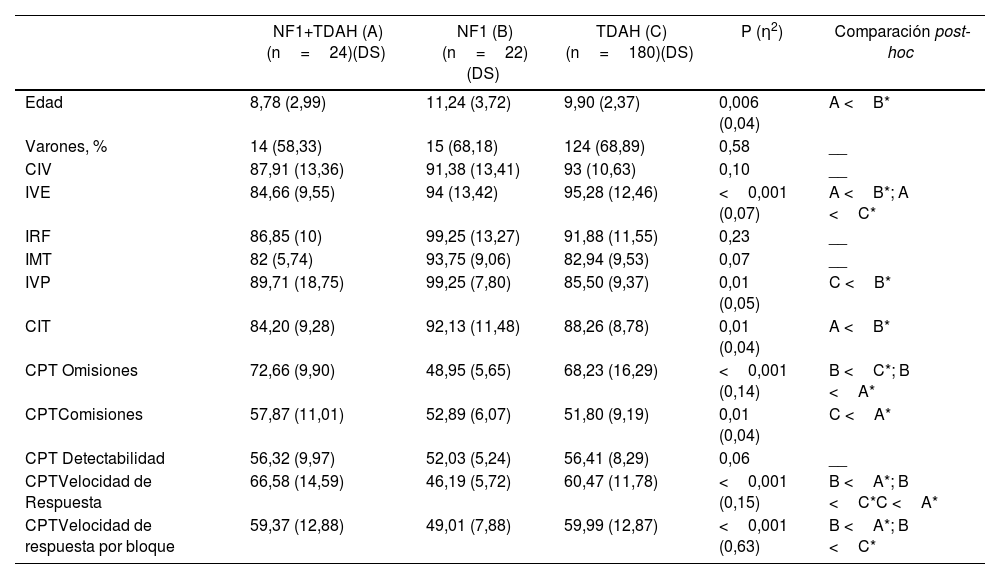La incidencia de TDAH en pacientes con NF1 llega al 60%. Más allá de la bibliografía publicada sobre aspectos cognitivos en sujetos con NF1, algunos estudios indican que el perfil atencional de los pacientes con NF1+TDAH es distinto de los sujetos con TDAH solo.
MétodosEstudio retrospectivo, analítico de casos y controles con el objetivo de comparar el perfil intelectual y atencional en niños con NF1+TDAH, NF1 y TDAH solo para caracterizarlos constatando similitudes y diferencias.
ResultadosSe revisaron evaluaciones neuropsicológicas de 2017 a 2021 de todos los sujetos con diagnóstico de NF1 (n=46) con CIT> 70 y TDAH (n=180). En la prueba ANOVA se observó que los pacientes con NF1+TDAH presentaron mayor deterioro visuoespacial (M=84,66; F(2,210)=7,84; p <0,001; η2=0,07) y menor nivel intelectual total (M=84,20; F(2,223)=4,35; p=0,01; η2=0,04); en las pruebas atencionales mostraron más errores por omisión (M=72,66; F(2,223)=18,13; p <0,001; η2=0,14) y por comisión (M=57,87; F(2,223)=4,68; p=0,01; η2=0,04) y menor velocidad de reacción (M=66,58; F(2,223)=19,24; p <0,001; η2=0,15) en comparación con los pacientes con NF1 y TDAH aislado.
ConclusionesEl déficit atencional en los pacientes con NF1 se asocia a un menor rendimiento en el funcionamiento intelectual y mayor compromiso visoespacial. El patrón atencional de los pacientes con NF1+TDAH fue diferente de los sujetos con TDAH solo; la diferencia fue no solo cuantitativa, sino también cualitativa, lo que sustenta la hipótesis de que el deterioro de la atención tiene rasgos propios de la NF1 e independientes del TDAH.
The incidence of ADHD in patients with NF1 reaches 60%. Beyond the published literature on cognitive aspects in subjects with NF1, some studies suggest that the attentional profile of patients with NF1+ADHD is different from those with isolated ADHD.
MethodsA retrospective, analytical case-control study with the objective of comparing the intellectual and attentional profile in children with NF1+ADHD, NF1 and isolated ADHD in order to characterise them, noting similarities and differences.
ResultsNeuropsychological evaluations from 2017 to 2021 were reviewed for all subjects with a diagnosis of NF1 (n=46) with IQ>70 and ADHD (n=180). In the ANOVA test, it was observed that patients with NF1+ADHD presented with greater visuospatial impairment (M=84.66; F(2,210)=7.84; P<0.001; η2=0.07) and a lower total intellectual level (M=84.20; F(2,223)=4.35; P=0.01; η2=0.04). In the attentional tests they showed more errors of omission (M=72.66; F(2,223)=18.13; P<.001; η2=0.14) and of commission (M=57.87; F(2,223)=4.68; P=0.01; η2=0.04) and lower reaction speed (M=66.58; F(2,223)=19.24; P<0.001; η2=0.15) compared to patients with NF1 and isolated ADHD.
ConclusionsAttention deficit in patients with NF1 is associated with lower performance in intellectual functioning and greater visuospatial impairment. The attentional pattern of patients with NF1+ADHD was different from those with isolated ADHD; the difference being not only quantitative but also qualitative, supporting the hypothesis that attention impairment has its own features of NF1 and independent of ADHD.







